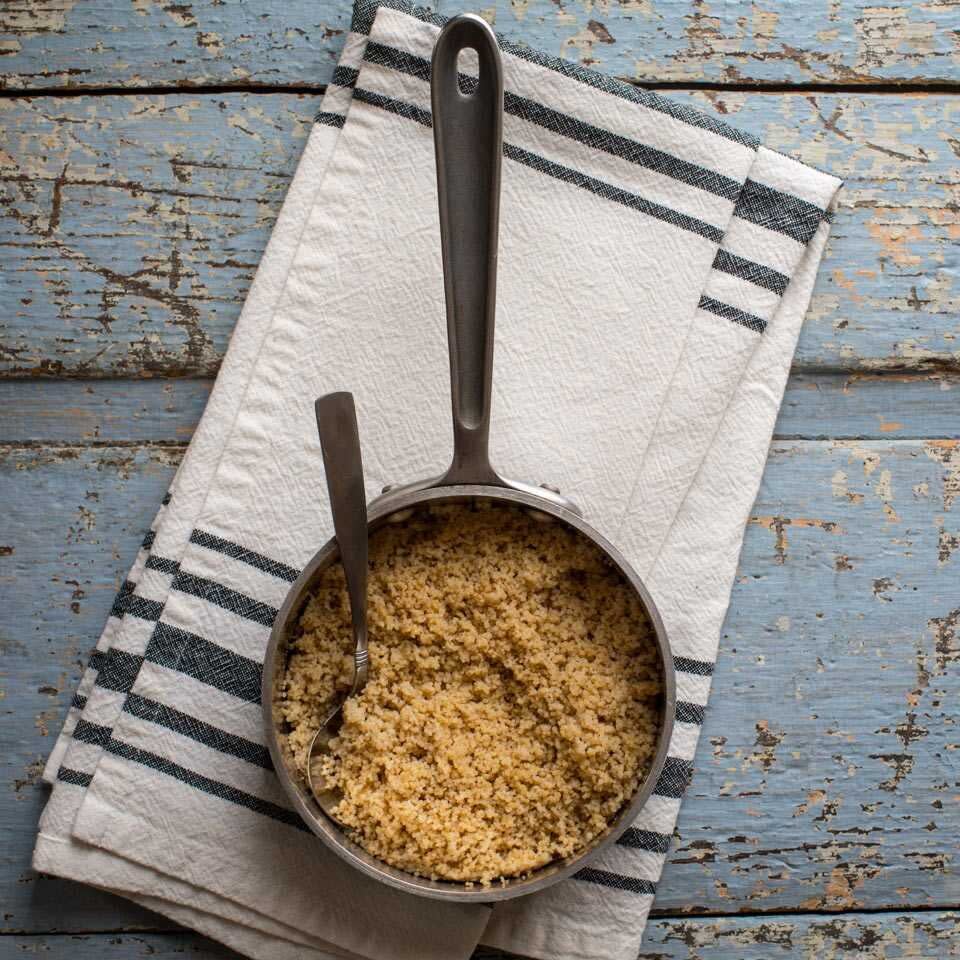Is Couscous Healthy?
Couscous, a grain dish traditionally made from durum wheat semolina, has become a staple in many cultures. It's tossed into both raw and cooked vegetable salads, stirred into stews, and served straight-up as a side dish. You're probably familiar with the unique flavor and texture of couscous, but do you know anything about its nutritional profile? Let's dig into exactly what couscous is, which nutrients it delivers, and how you can enjoy it.
Related: Healthy Couscous Recipes
There are different types of couscous
Although it may look like a whole grain, couscous is actually a type of pasta. It's made from durum wheat semolina flour that's moistened with water and then tossed together until it forms the grain-like pellets that we call couscous.
"There are different types of couscous," says Divya L. Selvakumar, Ph.D., RD, a dietitian and the founder of Divine Diets. "Considering that couscous is a staple in North African and Middle Eastern cuisines, there are several varieties."

You might see couscous labeled as pearl couscous, or labeled from a region like, Morocccon, Israeli, or Lebanese couscous. The different varieties are made from the same type of semolina flour, but are formed into different shapes. Smaller couscous (as opposed to the larger pearl couscous) is the variety that's most common in the United States, with a relatively fine texture that cooks in just a few minutes. Pearl couscous, also called Israeli couscous, is made of larger balls of semolina that are chewier and take about 10 minutes to cook. Moghrabieh, also called Lebanese couscous, is made of even larger balls of semolina and takes about 15 minutes to cook.
Whole-wheat couscous is made from whole wheat durum flour, which contains all three parts of the grain (the endosperm, the germ, and the bran). "When able, purchase couscous that's made with whole-wheat flour, which is less processed and not stripped of nutrients like many pastas are," says Kelsey Lorencz, RDN, a dietitian and the owner of Graciously Nourished. Whole-wheat couscous is a bit harder to find, and it typically formed into small granules and a fine texture.
Couscous delivers fiber, carbs, protein, and some key minerals
One serving of couscous (⅓-cup dry, 1 cup cooked) delivers the following nutrients, according to the USDA:
Calories: 217
Fat: 0.5g
Saturated Fat: 0g
Unsaturated Fats: 0g
Carbohydrate: 45g
Sodium: 5mg
Fiber: 3g
Protein: 7g
Sugar: 0g
Added Sugars: 0g
Magnesium: 8% DV
Calcium: 2% DV
Potassium: 2% DV
Selenium: 78% DV
Selenium is an essential mineral that plays a key role in reproduction, thyroid hormone metabolism, and DNA synthesis, according to the National Institutes of Health (NIH). It also has antioxidant properties, which means that it protects against cell damage and infection. Couscous is packed with selenium, and delivers more than three-fourths of your daily needs in a one-cup serving.
Like other grains, couscous also delivers carbohydrates, fiber, and protein. Opt for the whole grain version and you'll get slightly more fiber and protein per cup, since these nutrients are found in the parts of the grain that are stripped during processing to make white flour.
Couscous isn't actually it's own grain, it's made from wheat, so it's not gluten free. It is naturally vegan, like other grains, and can be a delicious part of your diet.
Pictured above: Easy Whole-Wheat Couscous
Eating couscous with veggies and protein is a great way to get a variety of nutrients.
"Couscous, if eaten with vegetables and protein, can make a hearty meal and meet the daily recommended requirements for several nutrients, Selvakumar says, "Tagines are well known throughout North Africa, and provide an excellent meal for the entire family." Try serving couscous as the base for this Moroccan Chicken Tagine with Apricots and Olives. Selvakumar also recommends couscous as a side dish for curried vegetables, or with beans.
Lorencz recommends mixing warm couscous in with cooked vegetables like sauteed spinach, tomatoes, and garlic, then drizzling everything with lemon juice and topping it with roasted chickpeas.
You can sub couscous in for rice, as in this Whole-Wheat Couscous with Parmesan & Peas that tastes a bit like risotto. Or, you can serve it in a more traditional way, as part of a vegetable salad with herbs and some cheese.
Like all grain products, couscous can absolutely be part of a nutritious diet
Whole wheat couscous packs more nutrients than the regular version, which is made with processed semolina flour. You can find couscous in different forms at the store, but all are made from the same wheat and have the same nutritional value (except for whole-wheat couscous). No matter which type of couscous you choose, it's best to serve it up with veggies and some protein to make a nutritionally varied, satisfying meal.

